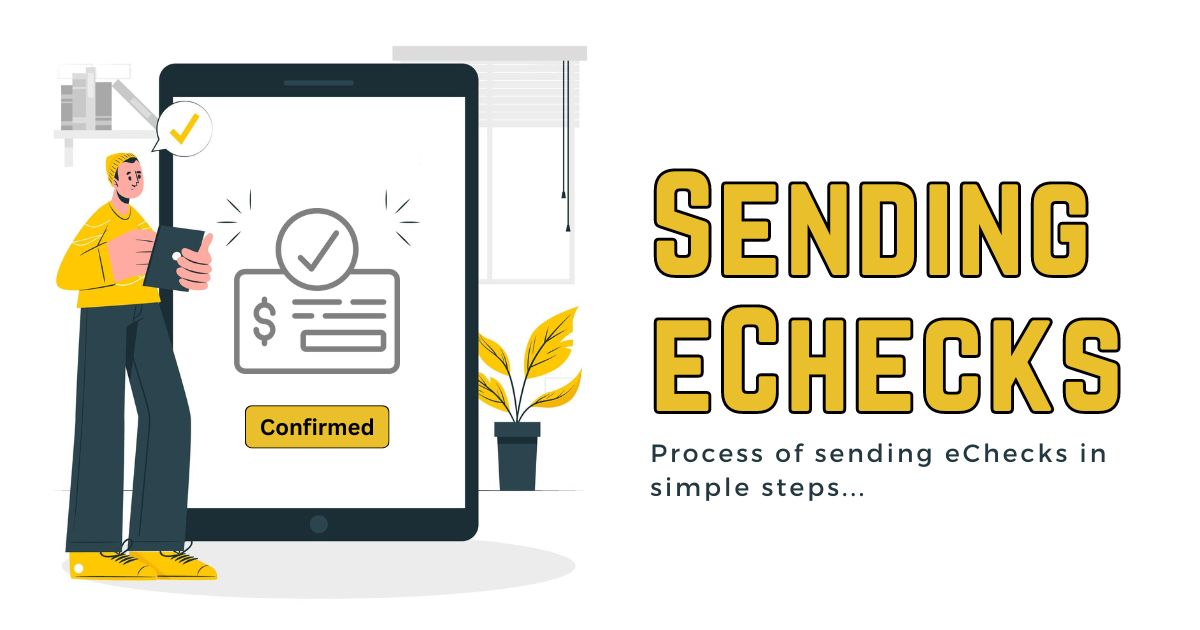
| May 23rd, 2022 |
Read To Know How You Can Send An eCheck In 3 Steps
In today’s fast-paced digital landscape, streamlining business transactions is key to staying ahead. Among the array of electronic payment methods available, eCheck stands out for its efficiency and ease of use. Understanding the process of sending eChecks in three simple steps can revolutionize the way businesses handle payments.
Step 1: Embrace an eCheck Service —
The first stride towards sending eChecks involves embracing an eCheck service provider. Various reputable online payment processors offer intuitive tools that enable the creation and dispatch of eChecks. Platforms such as Square’s POS system or Shopify provide accessible versions of digital bank transfers. Choosing a service that aligns with your business needs is crucial, considering factors like transaction volumes, processing fees, and compatibility with your business model.
Step 2: Set Up Payment Details —
Setting up payment details is pivotal in ensuring smooth eCheck transactions. To send eChecks through a merchant account, registration with an Automated Clearing House (ACH) merchant account is essential, particularly in the United States. This process entails providing comprehensive business information, tax identification numbers, and transaction volume details. This step is a foundational aspect of eCheck transactions, enabling a seamless flow of funds.
Step 3: Authorize and Initiate Payments —
Authorization is the crux of sending eChecks securely and accurately. When initiating an eCheck transaction, ensuring proper authorization through secure online forms or buyer contacts is imperative. Merchants must prioritize trust and security by using reliable payment processors to submit banking details. This step minimizes the likelihood of disputes arising from unauthorized transactions, laying the groundwork for swift and trouble-free eCheck processing.
The Benefits of Sending eChecks —
Understanding the advantages of eChecks further emphasizes their appeal for businesses seeking efficient payment methods. eChecks, the digital counterpart of paper checks, boasts rapid processing times within online banking networks. This expediency saves both time and money while maintaining the safety and security of transactions. Additionally, the versatility of eChecks extends beyond traditional payment modes, offering benefits like enhanced security measures, cost-effectiveness, and a reduced need for physical paperwork, stamps, or signatures.
eChecks — A Transformative Payment Solution:
The ease and efficiency of sending eChecks in just three steps herald a transformative era in transaction processing. By embracing this digital payment method, businesses can revolutionize their payment systems, expediting transactions while minimizing operational costs. Furthermore, the heightened security measures and versatility of eChecks position them as a robust and preferred choice for businesses of all scales.
Implementing eChecks — A Strategic Business Move:
Transitioning to eChecks represents a strategic leap towards modernizing payment methodologies. The simplicity of sending eChecks in three steps reshapes the landscape for businesses, irrespective of their scale or industry. This digital evolution fosters efficiency, cost-effectiveness, and heightened security, setting the stage for a new era of transaction processing.
Enhancing Financial Operations with eChecks —
The integration of eChecks into financial operations amplifies the efficiency quotient. Swift transactions, expedited processing times, and reduced administrative burdens are just the beginning. The elimination of paper, stamps, and signatures streamlines processes, aligning businesses with eco-friendly practices while trimming operational costs.
Security Beyond Par —
Security remains a paramount concern in the realm of financial transactions. With eChecks, advanced security measures like multi-factor authentication and robust encryption fortify payment integrity, safeguarding transactions against potential breaches. This heightened security mitigates the risks of altering paper checks, assuring businesses and clients of enhanced safety.
The Versatility of eChecks —
Beyond their convenience, eChecks boast versatility. They cater to many payment scenarios, from regular supplier transactions to rent, mortgage, dues, and membership fees across diverse industries. Their acceptance by vendors as a preferred payment mode signifies their reliability and adaptability, making them an invaluable asset for businesses seeking comprehensive payment solutions.
Embracing Efficiency, Embracing eChecks —
Adopting eChecks signifies more than just embracing a digital payment mode; it represents a commitment to efficiency, security, and adaptability. Small businesses, in particular, benefit from evading the substantial fees linked to credit and debit card payments, paving the way for streamlined financial operations and enhanced profitability.
Future Outlook — The eCheck Advantage:
As technology evolves, the significance of eChecks in the payments landscape will only amplify. Their ability to cater to various payment scenarios and their resilience in ensuring secure and rapid transactions positions them as a cornerstone of future financial operations. By understanding and embracing the simplicity of sending eChecks, businesses equip themselves with a versatile, secure, and efficient payment tool for the evolving digital economy.
Embrace the Future of Transactions —
The three-step process of sending eChecks encapsulates the evolution from traditional to modern payment methodologies. Businesses that seize this opportunity to incorporate eChecks into their operations stand poised to optimize efficiency, bolster security, and adapt seamlessly to the dynamic digital landscape.
Mastering the art of sending eChecks is not merely about simplifying transactions; it’s about transforming the way businesses operate. It’s a strategic shift towards a future where efficiency, security, and adaptability converge, ensuring businesses thrive in an ever-evolving financial ecosystem.
Conclusion —
Mastering the art of sending eChecks in three simple steps holds the potential to redefine how businesses handle their transactions. This streamlined process not only ensures quicker payments but also enhances security and reduces operational expenses. As the digital landscape continues to evolve, embracing eChecks emerges as a strategic move for businesses aiming for efficiency and security in their financial transactions.